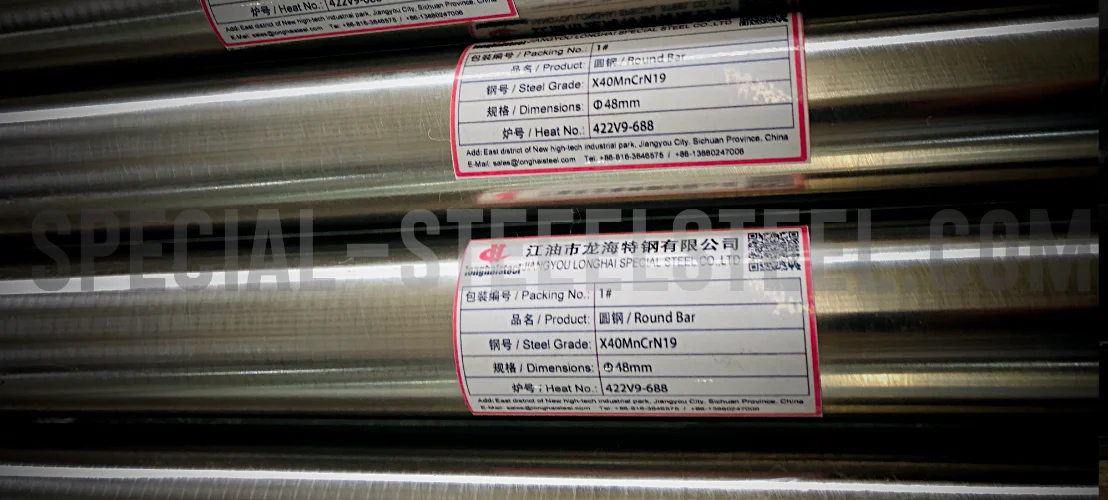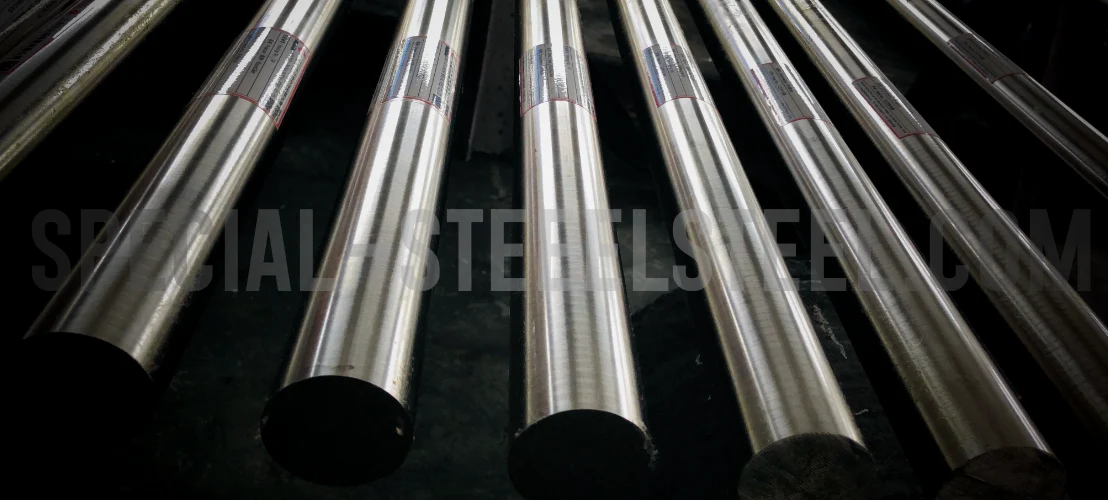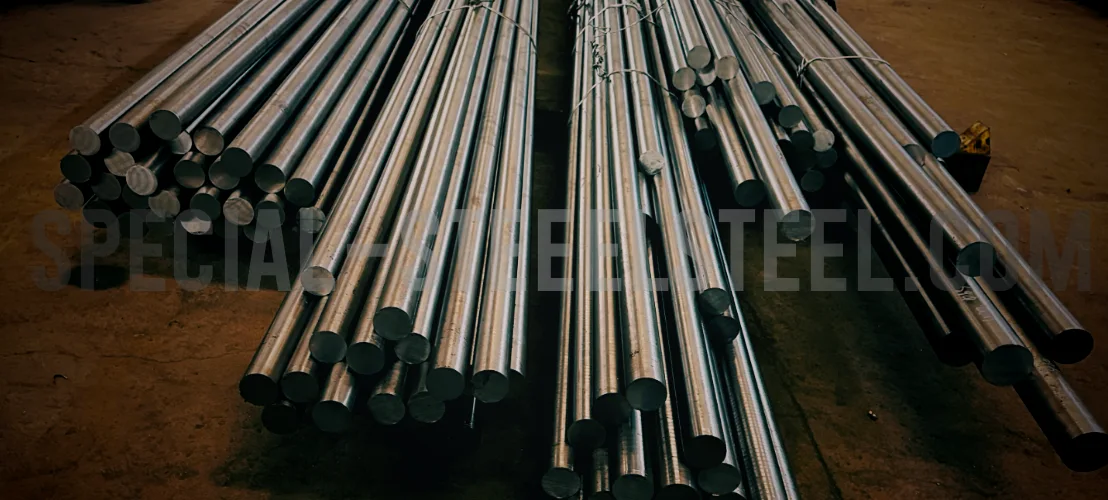X40MnCrN19K, 1.3813
X40MnCrN19K / 1.3813, as specified in Siemens TLV 9384.01: 2002-11, is a high-manganese austenitic stainless steel optimized for high strength (≥500 MPa yield strength, 850–1250 MPa tensile strength), good ductility (≥20% elongation), and moderate corrosion resistance. Its high carbon content (0.35–0.45%) and low nickel (1.0–2.0%) make it a cost-effective alternative to 300-series alloys, suitable for power generation, food processing, automotive, and chemical applications.



Table of Contents
What is X40MnCrN19K, 1.3813?
X40MnCrN19K is a high-manganese austenitic stainless steel, characterized by its face-centered cubic (FCC) austenitic microstructure, which imparts excellent ductility, toughness, and corrosion resistance. This alloy belongs to the 200-series stainless steels, utilizing manganese and nitrogen as partial substitutes for nickel to stabilize the austenite phase, making it a cost-effective alternative to nickel-rich 300-series alloys like 304 and 316. The high manganese content enhances work-hardening capabilities, while chromium and nitrogen contribute to corrosion resistance and mechanical strength. The designation "X40MnCrN19K" indicates approximately 0.40% carbon, high manganese, chromium, and nitrogen, with "K" potentially denoting a specific variant or proprietary modification, as specified in Siemens TLV 9384.01: 2002-11.
This alloy is designed for applications requiring high strength, good corrosion resistance in moderate environments, and excellent formability. Its non-magnetic nature in the annealed condition and ability to achieve high strength through cold working make it suitable for demanding applications. However, its high work-hardening rate and lower nickel content compared to 300-series alloys can affect machinability and welding performance, requiring specific processing considerations, as outlined in the Siemens specification.
Applications
X40MnCrN19K / 1.3813 is used in industries where cost efficiency, corrosion resistance, and high mechanical strength are critical. Typical applications include:
- Power Generation Components: Specified in Siemens TLV 9384.01 for high-strength bars used in critical components, ensuring reliability under service stresses.
- Food Processing Equipment: Used in kitchen appliances, utensils, and processing machinery due to its hygiene, corrosion resistance, and formability.
- Automotive Components: Employed in exhaust systems, structural parts, and decorative trims where moderate corrosion resistance and high strength are needed.
- Chemical and Petrochemical Industries: Suitable for pipes, tanks, and fittings exposed to mildly corrosive environments.
- Construction and Architecture: Applied in structural components and decorative panels where aesthetic appeal and durability are required.
- Medical Devices: Utilized in non-implantable components like surgical tools due to its corrosion resistance and ability to be cold-worked into precise shapes.
- General Engineering: Used in springs, fasteners, and other high-strength components benefiting from cold work hardening.
Chemical Composition (%)
The chemical composition of X40MnCrN19K is specified in Siemens TLV 9384.01: 2002-11, providing precise limit values for high-manganese austenitic stainless steel. Below is the composition, compared with similar grades like AISI 201 and 202 for reference.
| Element | X40MnCrN19K(TLV 9384.01) |
AISI 201 | AISI 202 |
|---|---|---|---|
| Carbon (C) | 0.30–0.50% | ≤0.15% | ≤0.15% |
| Chromium (Cr) | 3.0–5.0% | 16.0–18.0% | 17.0–19.0% |
| Manganese (Mn) | 18.0–20.0% | 5.5–7.5% | 7.5–10.0% |
| Nickel (Ni) | - | 3.5–5.5% | 4.0–6.0% |
| Nitrogen (N) | 0.08–0.12% | ≤0.25% | ≤0.25% |
| Silicon (Si) | ≤0.50% | ≤1.0% | ≤1.0% |
| Phosphorus (P) | ≤0.050% | ≤0.060% | ≤0.060% |
| Sulfur (S) | ≤0.015% | ≤0.030% | ≤0.030% |
| Iron (Fe) | Balance | Balance | Balance |
Notes:
- The Siemens specification (TLV 9384.01) defines stricter limits for phosphorus (≤0.035%) and sulfur (≤0.015%) compared to typical 200-series alloys, enhancing cleanliness and reducing inclusions.
- The high carbon content (~0.40%) increases strength but may reduce weldability due to potential carbide precipitation.
- Manganese and nitrogen stabilize the austenite phase, reducing the need for nickel, which lowers costs compared to 300-series alloys.
- Chromium provides corrosion resistance, while nitrogen enhances pitting resistance and strength.
Material Properties
The mechanical properties of X40MnCrN19K are specified in Siemens TLV 9384.01: 2002-11 for the delivery condition (likely solution-annealed or lightly cold-worked, as austenitic steels are not heat-treatable for hardening). Properties are tested with specimens taken from the center of bars (20 mm diameter for tensile tests). Below are the specified properties, compared with estimated properties for cold-worked conditions based on similar alloys.
| Condition | Yield Strength (0.2% Offset, MPa) | Tensile Strength (MPa) | Elongation (%) | Reduction of Area (%) | Impact Energy (J) | Hardness (HB30) |
|---|---|---|---|---|---|---|
| TLV 9384.01 (Delivery Condition) | ≥500 | 850–1250 | ≥20 (l₀=5d) | ≥35 | ≥90 (Charpy-V, avg. of 3) | 260–360 |
| Annealed (+A, Estimated) | 250–300 | 600–800 | 40–60 | 40–60 | ≥100 | ≤220 |
| Cold Worked (1/4 Hard) | 400–600 | 800–1000 | 20–40 | 30–50 | 80–100 | 220–280 |
| Cold Worked (1/2 Hard) | 600–800 | 1000–1200 | 10–20 | 20–40 | 60–80 | 280–350 |
Standards Compliance:
- Siemens TLV 9384.01: Specifies high yield strength (≥500 MPa), tensile strength (850–1250 MPa), and impact energy (≥90 J, average of 3 Charpy V-notch specimens) for bars in the delivery condition.
- EN 10088-2: Aligns with properties for high-manganese grades like 1.4372 (similar to AISI 201).
- ASTM A240: Covers chromium-manganese-nickel stainless steels, with X40MnCrN19K meeting similar requirements.
Notes:
- The high yield strength (≥500 MPa) in the delivery condition suggests a lightly cold-worked or optimized annealed state, as specified by Siemens.
- Cold working significantly increases strength and hardness, reducing ductility, making X40MnCrN19K ideal for high-strength applications.
- The high hardness range (260–360 HB30) indicates a robust material suitable for demanding environments but may pose machining challenges.
High-Temperature Mechanical Properties
X40MnCrN19K exhibits good strength at elevated temperatures due to its austenitic structure and alloying elements. The Siemens specification does not provide high-temperature data, so the following are estimated based on similar high-manganese austenitic steels.
| Temperature (°C) | Yield Strength (MPa) | Tensile Strength (MPa) | Elongation (%) |
|---|---|---|---|
| 20 | ≥500 | 850–1250 | ≥20 |
| 600 | 180–220 | 400–500 | 30–40 |
| 800 | 120–150 | 250–350 | 20–30 |
Notes:
- The high manganese and nitrogen content enhance creep resistance compared to standard 304, but performance is inferior to nickel-rich alloys like 310 or 316 at temperatures above 600°C.
- Applications above 800°C are limited due to reduced oxidation resistance compared to high-nickel grades.
Creep Performance
Creep resistance in X40MnCrN19K is moderate, suitable for applications up to 600–700°C. The alloy’s creep behavior is influenced by:
- Manganese and Nitrogen: These elements stabilize the austenite phase and reduce creep deformation by strengthening the matrix.
- Carbon Content: Higher carbon (0.35–0.45%) promotes carbide formation, which can enhance creep resistance but risks sensitization.
Typical Creep Data (extrapolated from similar alloys):
- Stress Rupture Strength: At 600°C, ~100 MPa for 10,000 hours.
- Creep Rate: ~10⁻⁶/s at 600°C under 50 MPa stress.
Notes:
- For prolonged high-temperature service, alloys like 310 or 347 with higher nickel or stabilizing elements (e.g., niobium) are preferred.
- Creep performance is adequate for short-term or intermittent high-temperature exposure in applications like power generation components.
Physical Properties
The physical properties of X40MnCrN19K are typical of austenitic stainless steels, with minor variations due to its high manganese and carbon content. The Siemens specification does not provide physical properties, so the following are based on typical values for similar alloys.
| Property | Value |
|---|---|
| Density | 7.8 g/cm³ |
| Melting Point | 1400–1450°C (2550–2640°F) |
| Thermal Conductivity | 15 W/m·K at 20°C (68°F) |
| Specific Heat Capacity | 500 J/kg·K |
| Coefficient of Thermal Expansion | 16–18 × 10⁻⁶/K (20–100°C) |
| Electrical Resistivity | 0.75 µΩ·m |
| Magnetic Properties | Non-magnetic (annealed); slightly magnetic after cold working |
Notes:
- The low thermal conductivity leads to heat concentration during machining or welding, requiring careful process control.
- The high thermal expansion coefficient can cause distortion in thin sections during welding, necessitating fixturing.
Heat Treatment
Austenitic stainless steels like X40MnCrN19K cannot be hardened by heat treatment due to their stable FCC structure. Instead, heat treatments are used for annealing or stress relief, while mechanical properties are enhanced through cold working. The Siemens specification does not detail heat treatment regimes but requires complete documentation of all heat treatments performed. Below are typical regimes, consistent with the alloy’s characteristics:
- **Solution Annealing (+A)**:
- Temperature: 1010–1065°C (1850–1950°F)
- Process: Heat to the specified temperature, hold to dissolve carbides, and rapidly cool (water or air quench) to prevent carbide precipitation.
- Purpose: Restores ductility, reduces residual stresses, and minimizes sensitization.
- Environment: Vacuum, hydrogen, or inert gas to prevent oxidation.
- Stress Relieving:
- Temperature: Below 450°C (840°F)
- Process: Hold at temperature to reduce residual stresses from forming or welding, followed by slow cooling.
- Purpose: Improves dimensional stability without affecting corrosion resistance.
- **Cold Working (+CW)**:
- Process: Cold rolling, drawing, or deformation to increase strength and hardness.
- Effect: Increases yield strength (e.g., from 250 MPa to 600–800 MPa) and hardness (up to 350 HB) but reduces ductility.
- Notes: Cold working is the primary method to achieve the high strength specified in TLV 9384.01 (≥500 MPa yield strength).
Sensitization Risk:
- Heating between 425–815°C (800–1500°F) can cause chromium carbide precipitation, leading to intergranular corrosion. Rapid cooling after annealing mitigates this risk.
- The high carbon content (0.35–0.45%) increases sensitization risk, requiring careful welding and heat treatment practices.
Processing Performance
Machining Performance
X40MnCrN19K’s high work-hardening rate and toughness, combined with its specified hardness (260–360 HB30), make it challenging to machine. Key considerations include:
- Tooling: Use sharp, high-speed steel or carbide tools to minimize work hardening. Dull tools exacerbate hardening and reduce tool life.
- Cutting Parameters: Employ low cutting speeds and high feed rates to prevent surface hardening. Use chip breakers to manage swarf.
- Coolants: Apply copious amounts of coolant to dissipate heat due to the alloy’s low thermal conductivity.
- Surface Finish: Achieving a smooth surface is difficult due to work hardening; polishing may be required for aesthetic applications.
Notes:
- The high hardness range (260–360 HB30) specified in TLV 9384.01 indicates increased machining difficulty compared to softer grades like 304 (≤220 HB).
- Compared to 304, X40MnCrN19K is more difficult to machine due to its higher manganese and carbon content.
Welding Performance
Welding X40MnCrN19K requires careful consideration due to its high carbon content (0.35–0.45%) and austenitic structure:
- Weldability: Good, but the high carbon content increases the risk of carbide precipitation and intergranular corrosion unless low-carbon filler materials are used.
- Filler Materials: Use 308L or 316L fillers with low carbon content to minimize sensitization. Ensure 5–10% ferrite in the weld to prevent hot cracking.
- Preheating: Not required, but post-weld annealing (949–1149°C, followed by rapid cooling) can restore corrosion resistance and ductility.
- Challenges:
- High thermal expansion and low thermal conductivity can cause distortion in thin sections; use fixturing to control warping.
- High manganese content may lead to fume generation, requiring proper ventilation.
- Welding Methods: Suitable for TIG, MIG, and shielded metal arc welding. Avoid arc welding without proper shielding gases.
Notes:
- Post-weld heat treatment is recommended for critical applications to dissolve carbides and restore corrosion resistance.
- Compared to 316L, X40MnCrN19K is more prone to sensitization due to its higher carbon content.
Non-Destructive Testing (NDT) Requirements
As specified in Siemens TLV 9384.01: 2002-11, X40MnCrN19K bars must undergo rigorous NDT to ensure internal and external quality:
- Scope of Inspection:
- Verification Test: Ensures material identity and prevents mix-ups.
- **Ultrasonic Testing (UT)**: Complete inspection per EN 10308 Type 1a–1c (Table 1), Quality Class 3 (Table 3). Decision limit for back wall echo loss is 3 dB. Linear or surface-like inhomogeneities >10 mm in any direction are unacceptable.
- Liquid Penetrant Testing: Per EN 10228-2, Quality Class 4 (Table 1), or equivalent method ensuring specified registration and decision criteria.
- Purpose: Detect internal defects (e.g., voids, inclusions) and surface cracks to ensure reliability in critical applications like power generation components.
Notes:
- The stringent NDT requirements reflect the alloy’s use in high-stress environments, ensuring defect-free material.
- UT and penetrant testing align with industry standards for high-quality stainless steel bars.
Similar Grades
| Grade | Standard | Notes |
|---|---|---|
| AISI 201 | ASTM A240 | Lower carbon (~0.15%), higher nickel (3.5–5.5%), similar Mn content |
| AISI 202 | ASTM A240 | Similar to 201, with slightly higher nickel (4.0–6.0%) |
| 1.4372 | EN 10088-2 | European equivalent to AISI 201, with high Mn and low Ni |
| 1.4373 | EN 10088-2 | European equivalent to AISI 202, with balanced Mn and Ni |
| AISI 304 | ASTM A240 | Higher nickel (8–10.5%), lower Mn, better corrosion resistance |
Notes:
- X40MnCrN19K’s higher carbon content (0.35–0.45%) and stricter sulfur/phosphorus limits distinguish it from 201/202, providing higher strength but reduced weldability.
- For applications requiring superior corrosion resistance, 304 or 316L may be preferred despite higher costs.
|
Grade
|
Size (mm)
|
Shape
|
Weight (kg)
|
Cond.
|
Melting
|
|
|---|---|---|---|---|---|---|
| No inventory data available | ||||||